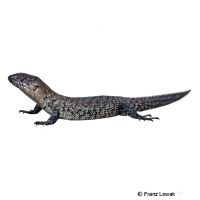Cunningham's Skink (Egernia cunninghami)
| Cunningham's Skink Egernia cunninghami | |
|---|---|
| Name | Cunningham's Skink |
| Name Lat. | Egernia cunninghami |
| Family | Skinks |
| Family lat. | Scincidae |
| Order | Scaled Reptiles |
| Order lat. | Squamata |
| Origin | Australia |
| Habitat | Semi-deserts |
| Diet | Insects, veggies |
| Humidity | 40-50 % |
| Behavior | Peaceful |
| Keeping | Pair, group |
| Care Level | Easy |
| Reproduction | Ovoviviparous |
| Housing | Dry terrarium |
| Life Span | 15-20 years |
| Protection | No |
| Metric Units | |
| Size | 40-45 cm |
| Temperature | 25-28 °C |
| Temperature Local | 40 °C |
| Housing Size | 150 x 100 x 75 cm |
| US Units | |
| Size | 16"-18" |
| Temperature | 77-82 °F |
| Temperature Local | 104 °F |
| Housing Size | 60" x 40" x 30" |
Distribution and habitat
The diurnal, ground-dwelling common spiny skinks are common in southeastern Australia, along the coast from southern Queensland through New South Wales to Victoria. They live in the dry desert fringes among rocks and flagstones.
Maintenance
Minimum dimensions for the terrarium, according to the size and number of animals
| 1-2 animals | 6KRL x 4KRL x 3KRL (L x W x H) |
Head-torso length (KRL) is measured on the largest animal. For each additional animal, increase the footprint by 15%. A terrarium of e.g. 150 x 100 x 75 cm is recommended, which should be placed in a quiet and vibration-free place
They need a dry terrarium with flat climbing branches, stone structures (hiding places, visual protection) and structured back and side walls (e.g. cork lining) as well as a shallow water bowl. Coarse sand or bird grit is suitable as substrate, covered with some dry leaves and debris, as well as planting for decoration (succulents, cacti, etc.). Once or twice a week the inside of the terrarium should be finely sprayed with water (humidity)
| Temp. day: 25-28 °C | Temp. night: 18-20 °C | Temp. local: up to 40 °C | Humidity: 40-50 |
Thermostatically controlled floor heating is recommended. The lighting duration must be 12-14 hrs. They need high light intensity and daily UV irradiation as well as sunny places with radiant heat.
Diet
The food supply consists of live insects, such as crickets, house crickets, grasshoppers, zophobas, etc., supplemented with sweet fruit (e.g. bananas), fruit pulp and finely chopped vegetables. Ready-to-eat foods for insectivorous reptiles are also frequently accepted. Wax moths should rarely be fed in very small amounts because of their large fat content. Regular addition of minerals and vitamins (e.g. by dusting the feeders) is important. Young animals should be offered food daily, adults 4-5 times a week. Drinking water must always be available
A regular and varied diet promotes health and prevents deficiency symptoms.
Reproduction and breeding
The sexes are difficult to distinguish. Males have a slightly broader head. A reliable sex determination is only possible by testosterone determination or endoscopy.
They are viviparous (ovoviviparous) and a litter consists of 3-8 young, which are protected by the parents. Suitable initial food for the young is small insects such as fruit flies, aphids, micro-unicates, etc
The life expectancy can be 15-20 years.
Important
They need hiding places and, according to their need for warmth, places to bask in the sun, such as climbing branches or stones irradiated by a spotlight
A hibernation period of approx. 2 months at a temperature of 10-15 °C and a lighting duration of approx. 8 hours is recommended
With fruit and honey water as food for the feeders, their quality can be upgraded.
The terrarium must have good ventilation without drafts and meet the species specific needs. Measuring devices such as thermometers, hygrometers, etc. are necessary. The lighting has to correspond to the species-specific day-night rhythm and has to be placed in such a way that the animals cannot injure themselves. The terrarium should be locked in such a way that neither unauthorized persons can open it nor the animals can escape. Contamination must be removed regularly.
Further literature can be found in your pet store.
References
Text: petdata; Image: Franz Lowak
Source: BMELV (1997): Tierschutzgutachten - Mindestanforderungen an die Haltung von Reptilien; ENGELMANN (2006): Zootierhaltung - Tiere in menschlicher Obhut: Reptilien und Amphibien, Harri Deutsch Verlag
- Gemäß § 21 Abs. 5 Tierschutzgesetz idgF
